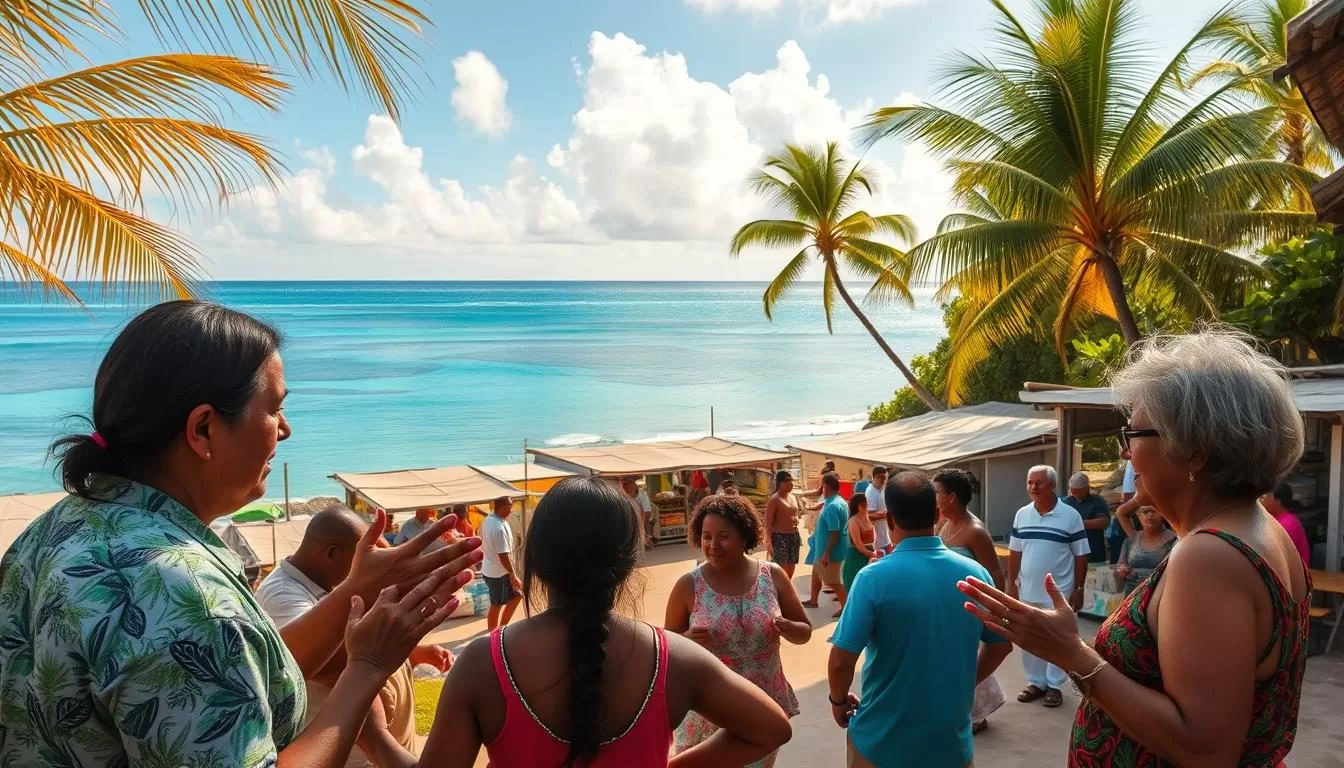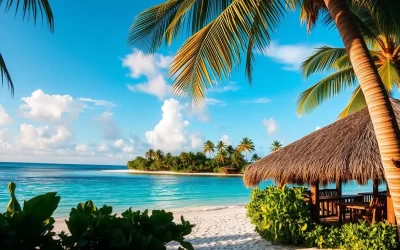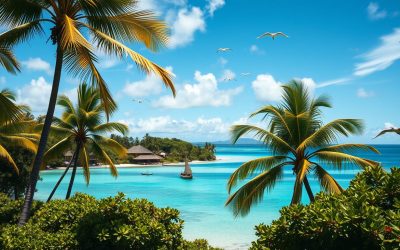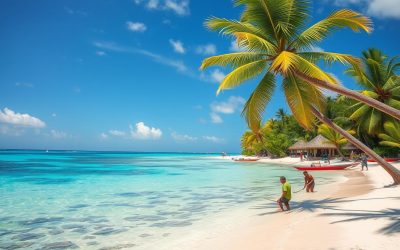✓ Accommodations✓ Flights✓ Rental Cars
Have you ever wondered how language shapes a country’s identity? In Kiribati, this connection is deeply rooted in its heritage. The official language here is Gilbertese, while English is also widely understood. These two languages play a vital role in connecting communities and preserving traditions.
The name “Ribaberiki Kiribati” reflects the nation’s ties to the Gilbert Islands. This island country is home to over 120,000 people, with more than half living on Tarawa island. Both Gilbertese and English are recognized as official languages, bridging the gap between tradition and modernity.
Understanding the significance of these languages helps you appreciate Kiribati’s unique culture. Whether it’s through daily communication or cultural practices, language remains a cornerstone of this Pacific nation.
Overview of Kiribati and Its Linguistic Heritage
The cultural identity of a nation is often shaped by its linguistic roots. In Kiribati, this is evident through the blend of Austronesian influences and modern adaptations. The language spoken here is more than a means of communication—it’s a bridge to the past and a foundation for the future.
Understanding the Cultural Mosaic
Kiribati’s cultural mosaic is a mix of traditions, beliefs, and practices. The community is deeply connected through shared values and customs. Over 98.8% of the population identifies as Micronesian, reflecting a strong sense of unity.
Language serves as a carrier of these traditions. From daily conversations to cultural ceremonies, it binds individuals across different levels of society. This connection is vital in preserving the nation’s heritage.
The Role of Language in Kiribati Identity
Language is a cornerstone of identity in Kiribati. It reflects the history of its people and their ties to the Gilbert Islands. English is widely used, making it easier for visitors to connect with locals.
For every person, language is a way to express their unique story. It’s a term that goes beyond words, encompassing traditions, values, and a shared sense of belonging.
| Aspect | Details |
|---|---|
| Population | Approximately 110,000 |
| Primary Language | Gilbertese |
| Secondary Language | English |
| Cultural Influence | Austronesian roots |
History and Cultural Background of Kiribati
The story of Kiribati is rooted in its early settlers. Austronesian migrations shaped the islands’ cultural and linguistic identity. These early inhabitants brought traditions that still influence daily life today.
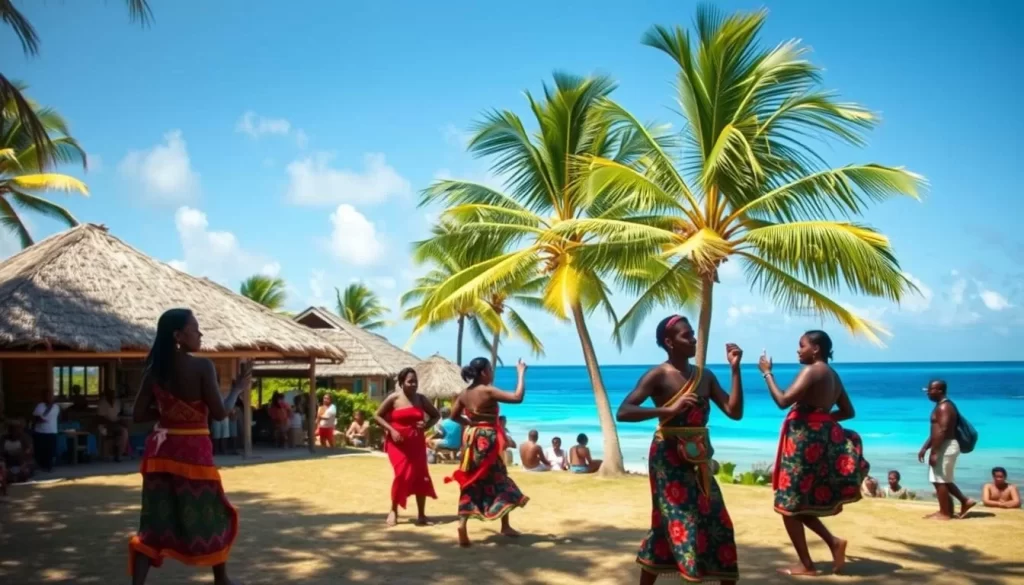
Early Inhabitants and Austronesian Influences
Thousands of years ago, Austronesian settlers arrived in the Gilbert Islands. They brought with them unique customs, language, and social structures. These elements became the foundation of the local culture.
Their influence is still visible in traditional practices and community life. The Gilbertese language, for example, reflects this rich heritage.
Colonial Era and Independence Milestones
In the late 19th century, the United Kingdom established a protectorate over the Gilbert and Ellice Islands. This marked the beginning of colonial rule, which lasted for decades.
Independence was granted in 1979, a pivotal year for the nation. The government worked to rebuild and preserve its cultural identity.
Evolution of Cultural Traditions
Cultural traditions in Kiribati have evolved over time. Indigenous practices blended with colonial influences, creating a unique cultural mosaic.
Mining, particularly phosphate mining, played a significant role in the economy. It also impacted social structures and community dynamics.
Today, these traditions continue to thrive, connecting the past with the present.
Kiribati: Official and Widely Spoken Languages
Language is the heartbeat of a nation’s identity. In Kiribati, it’s more than a tool for communication—it’s a reflection of heritage and unity. The name “Kiribati” itself carries centuries of cultural evolution, symbolizing the nation’s roots and resilience.
Gilbertese, spoken by over 96% of the population, is the primary language of Kiribati. English, widely understood, serves as a bridge for global interactions. Together, they form the backbone of the nation’s linguistic identity.
Official policies promote both languages, ensuring that content reflects historical and modern influences. This dual approach preserves traditions while fostering global connections. For example, 97% of residents can read Gilbertese, and 80% are proficient in English.
“Language is the road map of a culture. It tells you where its people come from and where they are going.”
The dialects of Gilbertese, including Northern and Southern variations, add depth to its linguistic landscape. These dialects highlight the diversity within the community.
| Aspect | Details |
|---|---|
| Primary Language | Gilbertese |
| Secondary Language | English |
| Literacy in Gilbertese | 97% |
| Literacy in English | 80% |
Understanding the role of language in Kiribati helps you appreciate its cultural richness. It’s a name that echoes history, a content that connects generations, and a voice that unites a nation.
Geographic and Environmental Context of Kiribati
The geography of Kiribati is as unique as its culture. This Pacific nation spans 33 islands and atolls, covering a total area of 811 square kilometers. These islands are scattered across an expansive sea territory, creating a breathtaking landscape.
Island Formation and Atoll Landscapes
Kiribati’s islands are divided into three groups: the Gilbert, Line, and Phoenix Islands. Each group has its own distinct features. The atolls, formed from coral reefs, are low-lying and surrounded by fringing reefs. This unique formation shapes the land and its ecosystems.
The total area of Kiribati is dispersed over approximately 3.5 million square kilometers of ocean. This vast sea territory plays a crucial role in the nation’s identity. The coastline stretches for 1,143 kilometers, offering stunning views and rich marine life.
Natural Features and Biodiversity
Kiribati’s natural features are a testament to its environmental richness. Lush vegetation covers many islands, while coastal reefs teem with diverse marine species. The atolls are home to unique ecosystems that support both terrestrial and aquatic life.
Agricultural land accounts for 42% of the nation’s total area. This includes arable land and permanent crops, which sustain local communities. The biodiversity of Kiribati is vital for its people and the environment.
“The beauty of Kiribati lies in its delicate balance of land and sea.”
| Feature | Details |
|---|---|
| Total Islands | 33 |
| Total Area | 811 sq km |
| Coastline Length | 1,143 km |
| Agricultural Land | 42% |
Understanding the geographic and environmental context of Kiribati helps you appreciate its natural wonders. From its islands to its atolls, this nation is a true marvel of nature.
Impact of Climate Change on Kiribati’s Sea Level and Communities
Climate change is reshaping the future of many island nations. Rising sea levels and global warming are transforming landscapes and communities. For low-lying atolls, these changes pose a direct threat to survival.
Rising Sea Levels and Environmental Risks
The highest elevation of Kiribati’s islands is only three to four meters above sea level. Predictions suggest that two-thirds of the atolls could be submerged by the end of this century. This alarming trend highlights the urgency of addressing environmental risks.
Groundwater salination is another critical issue. In less than 40 years, life on the islands may become unviable due to this change. Coastal inundation and loss of housing have already forced village relocations.
Adaptation Strategies and Resilience Efforts
Local communities are working to adapt to these challenges. Floating islands have been proposed as a solution, with an estimated cost of £874 million per community. However, the total cost of £19.2 billion far exceeds the nation’s GDP of $188.3 million.
International aid is also playing a role. The World Health Organization has allocated $6 million for the Te Mamauri project, aimed at enhancing climate resilience in health systems. This initiative targets higher-risk outer islands, addressing water quality and infrastructure.
“Adapting to climate change requires innovative solutions and global cooperation.”
Efforts like these are crucial for building resilience. As global warming continues, the need for sustainable strategies becomes more urgent. The future of Kiribati depends on effective adaptation and international support.
Government, Society, and Demographic Trends in Kiribati
Understanding how a nation’s government shapes its future is key to appreciating its progress. In this Pacific nation, the political framework reflects its history and guides its development. The unitary parliamentary system ensures that decisions are made with the community in mind.
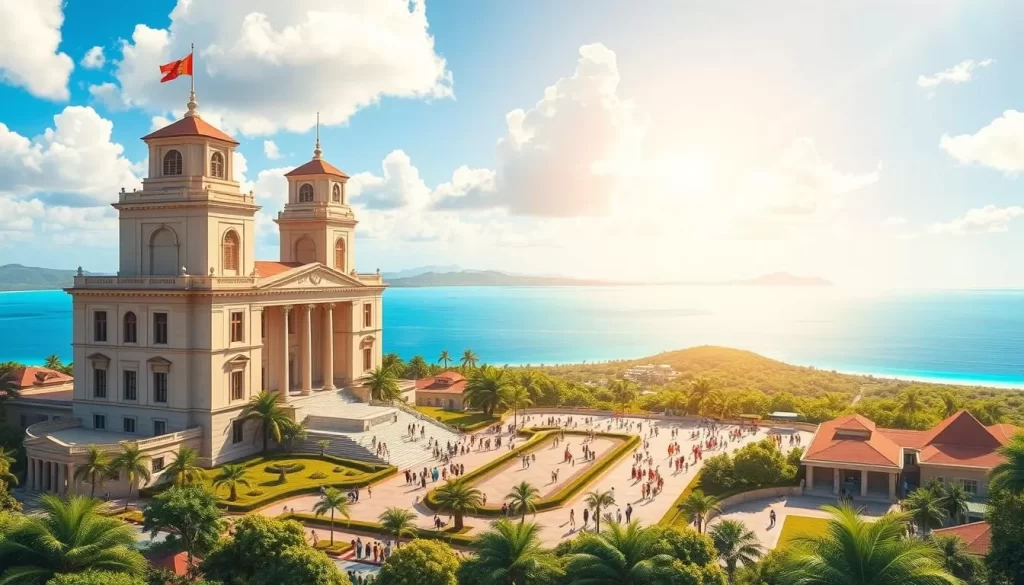
Political Structure and Governance
The government operates under a unitary republic system. The president, elected by the people, serves as both the head of state and government. This dual role allows for streamlined decision-making and policy implementation.
The legislative branch consists of a unicameral House of Assembly with 46 seats. Members are directly elected, ensuring representation across the islands. This structure promotes transparency and accountability in governance.
Urban-Rural Population Dynamics
Demographic trends reveal a shift toward urban centers. Over 56% of the population now resides in urban areas, with the capital, Tarawa, being the most populous. This trend impacts development priorities, as resources are allocated to meet growing urban needs.
Rural areas, however, remain vital to the nation’s identity. They preserve traditional practices and contribute to the cultural richness of the community. Balancing urban and rural growth is a key focus for the government.
“Effective governance bridges the gap between tradition and progress.”
- The president leads policy initiatives, ensuring alignment with national goals.
- Urbanization drives infrastructure investments, improving living standards.
- Rural areas maintain cultural heritage, fostering a sense of unity.
The Role of Education and International Aid in National Development
Education is a powerful tool for shaping a nation’s future. It empowers individuals, strengthens communities, and drives long-term growth. In this Pacific nation, both education and international aid play a pivotal role in securing food security and fostering resilience.
Educational institutions are the backbone of personal and national development. With 96% of eligible children attending primary school and a 94.1% completion rate, the foundation for progress is strong. These institutions not only impart knowledge but also prepare the youth for global opportunities.
Educational Institutions and Opportunities
International aid has been instrumental in bolstering infrastructure and the economy. Initiatives like the acquisition of land on Rabi Island in island Fiji provide future resettlement options, ensuring sustainability. Programs like the Uaiakinan ao Uarokoan Toronibwaia I-Kiribati (UUTI) initiative enhance English proficiency and job readiness, empowering students for economic mobility.
“Education is the most powerful weapon which you can use to change the world.”
- Education fosters personal growth and national progress.
- International aid supports infrastructure and economic stability.
- Initiatives like land acquisition on Rabi Island ensure future sustainability.
- Programs like UUTI prepare students for global opportunities.
These efforts are transforming communities, improving lives, and building resilience. By investing in education and leveraging international aid, this nation is paving the way for a brighter future. Learn more about how Kiribati students boost their skills in to see the impact of these initiatives firsthand.
Economic Overview: From Phosphate Mining to Copra Exports
The economy of this Pacific nation has undergone significant transformations over the years. Once driven by phosphate mining, it now relies on diverse revenue streams like copra exports and fishing licenses. These shifts reflect the nation’s adaptability in the face of global challenges.
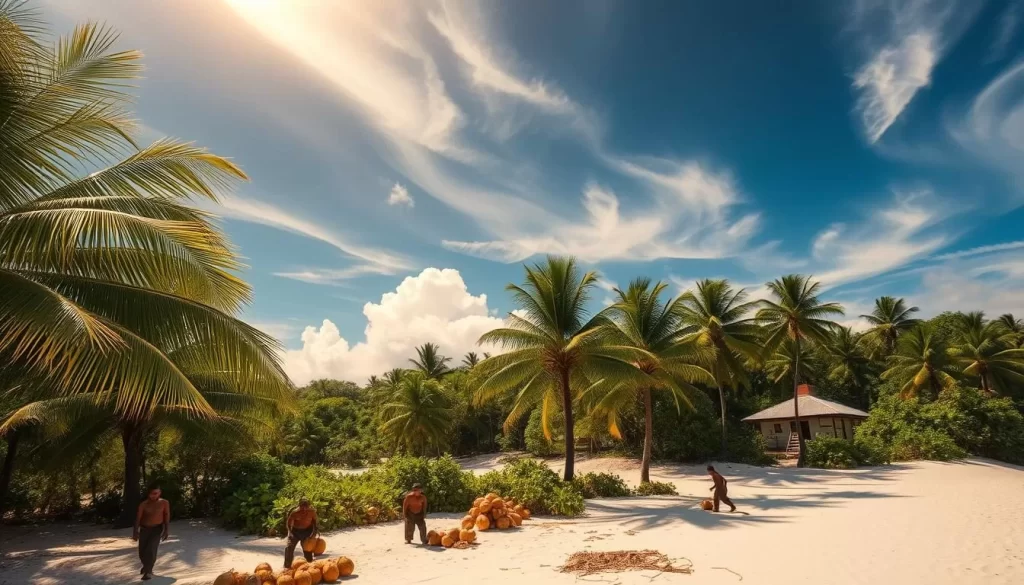
Historical Economic Drivers and Modern Shifts
For decades, phosphate mining was the backbone of the economy. The industry thrived from 1900 to 1979, providing jobs and revenue. However, as resources depleted, the nation had to pivot. Today, copra exports play a vital role, supporting local farmers and contributing to the economy.
This transition wasn’t easy. The decline in mining forced the government to explore new opportunities. Investments in agriculture and fishing helped stabilize the economy and create jobs.
Fishing Licenses, Deep-Sea Mining, and Foreign Aid
Fishing licenses have become a key revenue source. The nation’s vast Exclusive Economic Zone (EEZ) attracts international fleets, generating income. Additionally, deep-sea mining offers potential for future growth, though it comes with environmental challenges.
Foreign aid also plays a crucial role. It supports infrastructure projects and helps address food security. For example, the acquisition of land in Fiji ensures future sustainability.
“Adapting to economic changes requires innovation and resilience.”
Despite these efforts, challenges remain. Global financial pressures and reliance on imports impact local food production. The nation continues to seek sustainable solutions to strengthen its economy and improve livelihoods.
For more insights into the economic strategies of small island nations, explore this detailed analysis.
Media, Communication, and Global Connectivity
Communication plays a vital role in connecting people and shaping societies. In this Pacific nation, media serves as a bridge between communities and the world. From radio stations to newspapers, the media landscape is diverse and dynamic.
Freedom of speech is respected, with government-run and church-published outlets offering varied perspectives. This ensures a balanced flow of information and fosters public discourse. The service provided by these outlets helps keep the community informed and engaged.
Diverse Media Landscape and Freedom of Speech
Radio Kiribati is the only mass media form that reaches all islands, though it faces funding challenges. FM89, the sole commercial radio station, plays music exclusively, adding a cultural touch to daily life. Newspapers like Kiribati Newstar provide content in English, connecting locals with global news.
Despite limited resources, media outlets strive to deliver quality service. The government’s Press Unit produces newsletters, ensuring transparency and accountability. This commitment to clear communication empowers communities and strengthens global connectivity.
“A free press is essential for a thriving society.”
Efforts to improve internet and telephone connections are ongoing. However, high costs and limited access remain challenges. The result is a media landscape that, while evolving, continues to play a crucial role in national development.
For more insights into the cultural significance of communication, explore this detailed analysis.
Cultural Traditions and Community Life
Cultural traditions in Kiribati are deeply rooted in its history and community life. These practices have been maintained over the years through strong family ties and shared values. The country’s identity is shaped by its rich heritage, which continues to thrive in modern times.
Language plays a central role in cultural expression. The I-Kiribati language, spoken uniformly across the islands, connects people to their past. English, taught in schools, bridges the gap between tradition and global communication.
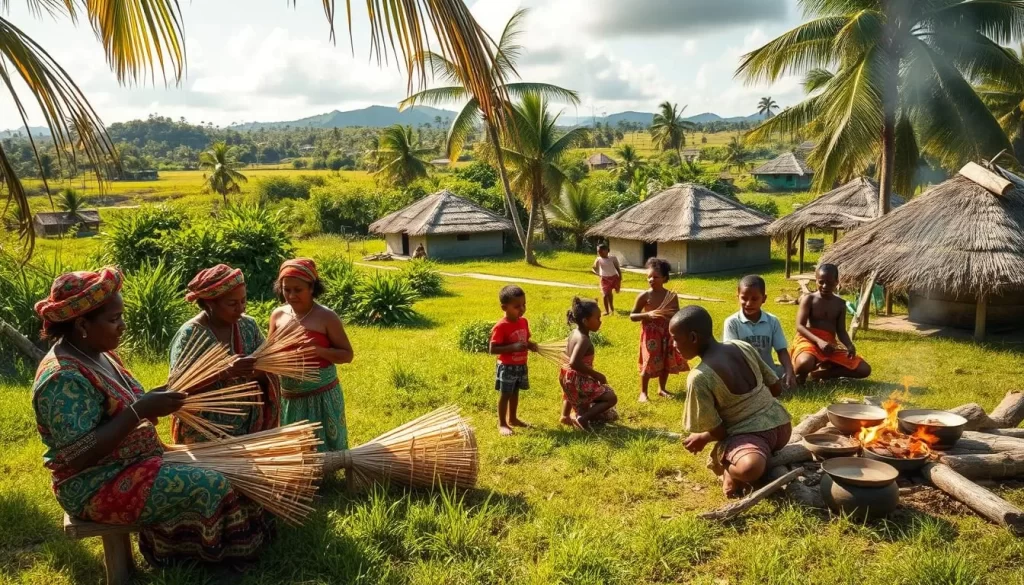
The dual naming system of “Gilbert Islands” and “Kiribati” is a significant cultural marker. It reflects the country’s history and its evolution over the years. This duality highlights the blend of colonial influence and indigenous identity.
Community life is guided by shared values and expectancys. Strong family ties and traditional practices foster a sense of unity. Over 80% of the population engages in subsistence agriculture and fishing, which are integral to daily life.
The influence of the Gilbert Ellice Islands heritage is evident in social traditions. These practices have been passed down through generations, preserving the country’s unique identity.
| Aspect | Details |
|---|---|
| Primary Language | I-Kiribati |
| Secondary Language | English |
| Cultural Influence | Gilbert Ellice Islands |
| Key Tradition | Subsistence Agriculture |
To learn more about Kiribati’s cultural heritage, explore how these traditions continue to shape the country’s future. The blend of history and community life offers a unique perspective on this Pacific nation.
Modern Challenges and Future Adaptations for Kiribati
The South Pacific faces unprecedented challenges as global warming reshapes its future. Rising sea levels and extreme weather events threaten the very existence of low-lying island nations. For Kiribati, these changes are not just predictions—they are a daily reality.
Global Warming and Climate Migration
Most of Kiribati’s land is less than three meters above sea level, making it highly vulnerable to rising waters. Over half of its population resides on South Tarawa, where the population density is 20 times the national average. This overcrowding, combined with environmental risks, has forced relocations in the past.
Climate migration is becoming a pressing issue. In the 1940s, many Banaba Island residents moved to Rabi Island in Fiji due to phosphate mining. Today, similar relocations are being considered as a response to environmental threats. The world must recognize the urgency of this situation and support affected communities.
Innovative Approaches to Sustainability
Kiribati is adopting innovative strategies to address these challenges. Projects like the National Adaptation Programs of Action (NAPA) aim to enhance resilience through infrastructure improvements and water resource management. These efforts are crucial for securing a sustainable home for its citizens.
International collaboration is also key. The South Pacific region relies on partnerships to tackle shared challenges. Kiribati, as a member of global climate initiatives, is actively seeking solutions to mitigate the impacts of environmental change.
“The future of Kiribati depends on innovative solutions and global cooperation.”
| Challenge | Adaptation Strategy |
|---|---|
| Rising Sea Levels | Coastal Zone Management Projects |
| Water Scarcity | Water Resource Adaptation Programs |
| Overpopulation | Relocation and Infrastructure Upgrades |
For more insights into how Kiribati is addressing these challenges, explore this detailed analysis. The nation’s efforts highlight the importance of resilience and innovation in the face of global warming.
Conclusion
From its unique geography to its resilient culture, this island nation stands as a testament to adaptability. The country’s identity is shaped by its language, governance, and response to environmental change. With a population of approximately 135,000, over half reside on Tarawa Atoll, highlighting the challenges of overcrowding.
The economy has evolved from phosphate mining to reliance on coconut exports and fishing licenses. This shift reflects the nation’s ability to adapt to global pressures. The president plays a crucial role in guiding policies that balance tradition and progress.
Environmental threats, like rising sea levels, pose significant risks to low-lying atolls. Yet, innovative strategies and international support offer hope for a sustainable future. The name of this nation echoes its history, while its people continue to navigate the challenges of today.
The above is subject to change.
Check back often to TRAVEL.COM for the latest travel tips and deals.
